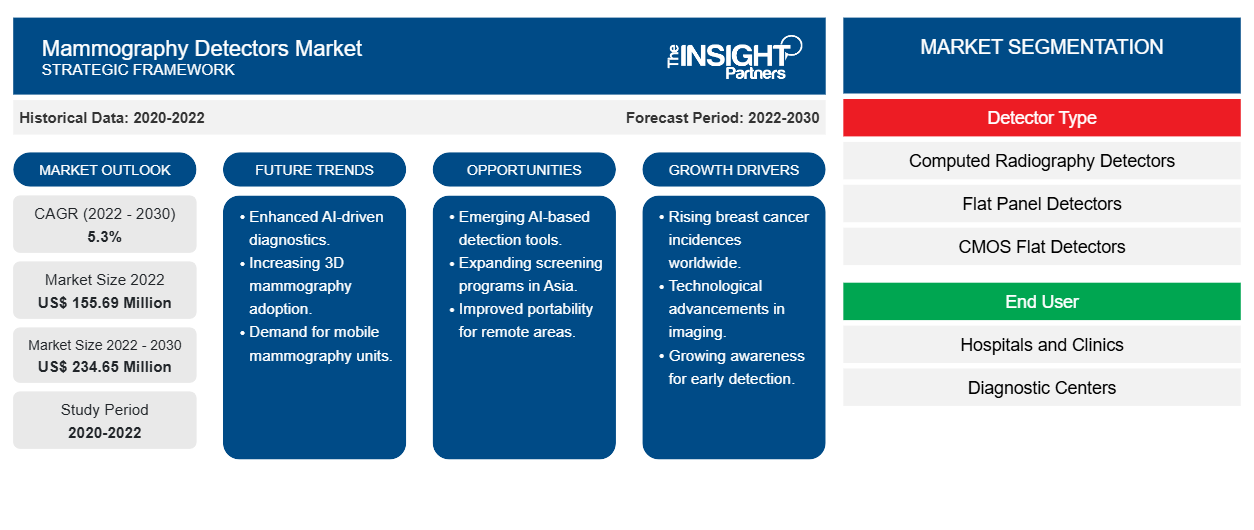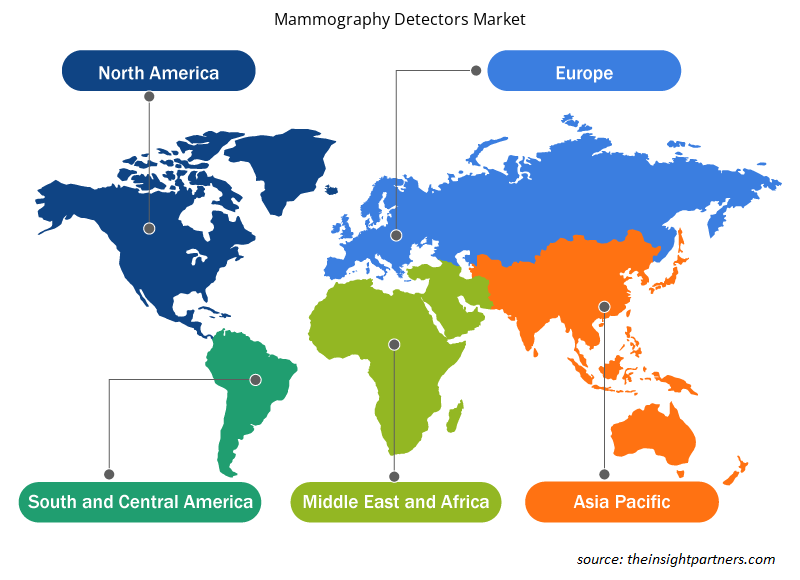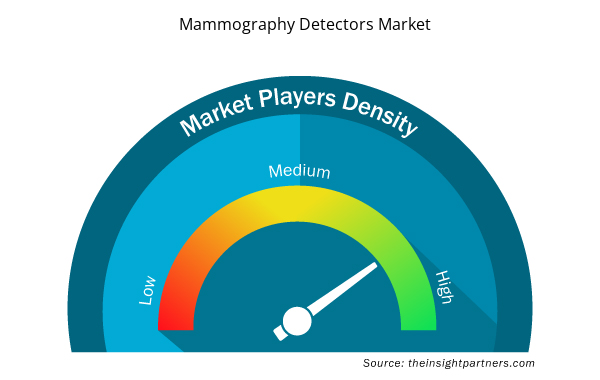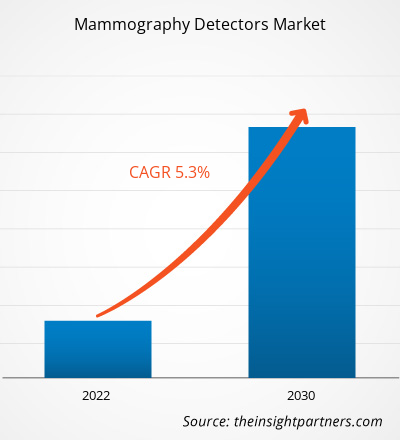[Research Report] The mammography detectors market size is projected to grow from US$ 155.69 million in 2022 to US$ 234.65 million by 2030; it is estimated to record a CAGR of 5.3% during 2022–2030.
Market Insights and Analyst View:
Mammography detector-based imaging has become an essential part of the breast cancer detection process. Mammography is a diagnostic and screening technique that involves using low-energy X-rays to examine human breasts for the possibility of breast cancer based on distinct lumps or microcalcifications, thereby diagnosing the condition in its early stage. Mammography detectors use low-dose X-rays to identify cancer before symptoms appear in females. Several mammography detectors available in the market include computer radiography detectors, flat panel detectors, and CMOS flat panel detectors.
Growth Drivers:
Breast cancer is the world’s most diagnosed cancer type. A few of the usual symptoms of breast cancer include the appearance of inverted nipples, changes in breast shape, development of lumps in the breast, and red or scaly patches on skin or sore nipples. Factors such as lifestyle changes, hormonal imbalances, genetic predisposition, and environmental factors contribute to the rising prevalence of breast cancer. As per the World Health Organization, ~ 2.3 million women in the world were diagnosed with breast cancer in 2020, while 685,000 cases resulted in death. The International Agency for Research on Cancer projected that the incidence of breast cancer would increase by more than one-third by 2040, to over 3 million new cases per year; the annual number of deaths due to the disease is expected to rise by more than half to reach ~1 million. The prevalence of breast cancer is growing globally and has resulted in heightened demand for mammography detectors market for diagnosis.
Breast cancer is one of the most common types of cancer in the US. A report published by Breastcancer.org in January 2022 stated that 1 in 8 women in the country (or ~13%) would suffer from invasive breast cancer over their lifetime. According to the same source, 287,850 new incidences of invasive breast cancer, along with 51,400 new cases of noninvasive (in situ) breast cancer, were detected in women in the US in 2022. In the same year, the country recorded ~2,710 additional cases of invasive breast cancer in men. Approximately 1 in 833 men are at risk of developing breast cancer throughout their lives. It is also the most common type of cancer found in German women. As per Globocan 2020, nearly 69,697 new instances of breast cancer were reported in 2020 in Germany, representing 11.1% of all registered cancer cases. The disease caused 20,579 fatalities, and the five-year prevalence rate of breast cancer in all ages was 707.38 per 100,000 population. The Bundesamt für Strahlenschutz study on mammography in Germany states that despite significant progress in breast cancer treatment, ~17,000 women succumb to death due to this disease. Breast cancer treatment costs almost US$ 2.13 billion (EUR 2 billion) annually. As per the National Health Service data, about 1 in 7 women are diagnosed with breast cancer during their lifespan in Great Britain. Each year, ~55,000 women are diagnosed with breast cancer.
Three imaging techniques are used for the diagnosis of breast cancer: X-ray mammography (examination of the breast using a low-dose X-ray system), sonography, and magnetic resonance imaging. Mammography is the standard diagnostic and screening technique for screening breast tissues to check the presence of a malignant tumor. The procedure involves using low-energy X-rays. Mammography detectors are devices that use breast X-rays to detect and diagnose breast cancer. Special X-ray images help spot abnormal growth or alterations in breast tissues, aiding in the early detection of breast cancer.
Thus, the incidence of breast cancer is anticipated to increase in the coming years, driving the mammography detector market growth, as mammography is the most efficient method to screen for breast cancer in women showing no symptoms.
Customize This Report To Suit Your Requirement
You will get customization on any report - free of charge - including parts of this report, or country-level analysis, Excel Data pack, as well as avail great offers and discounts for start-ups & universities
Mammography Detectors Market: Strategic Insights

- Get Top Key Market Trends of this report.This FREE sample will include data analysis, ranging from market trends to estimates and forecasts.
Customize This Report To Suit Your Requirement
You will get customization on any report - free of charge - including parts of this report, or country-level analysis, Excel Data pack, as well as avail great offers and discounts for start-ups & universities
Mammography Detectors Market: Strategic Insights

- Get Top Key Market Trends of this report.This FREE sample will include data analysis, ranging from market trends to estimates and forecasts.
Report Segmentation and Scope:
The mammography detectors market is segmented on the basis of detector type, end user, and geography. Based on detector type, the market is categorized into computed radiography detectors, flat panel detectors, CMOS flat detectors, and others. The mammography detectors market, by end users, is segmented into hospitals and clinics, and diagnostic centers. The mammography detectors market, based on geography, is segmented into North America (US, Canada, and Mexico), Europe (France, Germany, UK, Spain, Italy, and Rest of Europe), Asia Pacific (China, India, Japan, Australia, South Korea, and Rest of Asia Pacific), the Middle East & Africa (Saudi Arabia, UAE, South Africa, and Rest of Middle East & Africa), and South & Central America (Brazil, Argentina, and Rest of South & Central America).
Segmental Analysis:
The mammography detectors market, by detector type, is categorized into computed radiography detectors, flat panel detectors, CMOS flat detectors, and others. The flat panel detectors segment held the largest share of the market in 2022. The CMOS flat detectors segment is expected to register the highest CAGR in the mammography detectors market during 2022–2030.
Based on end user, the mammography detectors market is categorized into hospitals and clinics, and diagnostic centers. In 2022, the hospitals and clinics segment held a larger share of the market, and it is further expected to register a higher CAGR during 2022–2030.
Regional Analysis:
The mammography detectors market is primarily divided into North America, Europe, Asia Pacific, South & Central America, and the Middle East & Africa. In 2022, North America captured a significant share of the market. The US held the largest share of the market in this region in 2022. The market growth in North America is attributed to easy access to technologically advanced detectors, the rising cases of breast cancer, and the presence of well-established healthcare infrastructure. According to the Centers for Disease Control and Prevention, 239,612 new cases of breast cancer were reported among women in the US in 2020, of which ~42,273 succumbed to death. For every 100,000 women, 119 new breast cancer cases in women were reported, while nearly 19 died due to the disease. As per the breast cancer statistics by the Breast Cancer Organization, 1 in 8 women (nearly 12%) is at risk of developing invasive breast cancer in their lifetime.
As breast cancer is the most prevalent cancer in Canadian women and the second leading reason for cancer-related deaths, there is a high demand for efficient diagnosis options in the country. According to the Canadian Cancer Society, ~28,600 Canadian women were diagnosed with breast cancer in 2022, accounting for ~25% of all new cancer cases in women. 1 in 8 Canadian women is estimated to develop breast cancer during their lifetime.
Mammography Detectors Market Regional Insights
The regional trends and factors influencing the Mammography Detectors Market throughout the forecast period have been thoroughly explained by the analysts at Insight Partners. This section also discusses Mammography Detectors Market segments and geography across North America, Europe, Asia Pacific, Middle East and Africa, and South and Central America.

- Get the Regional Specific Data for Mammography Detectors Market
Mammography Detectors Market Report Scope
| Report Attribute | Details |
|---|---|
| Market size in 2022 | US$ 155.69 Million |
| Market Size by 2030 | US$ 234.65 Million |
| Global CAGR (2022 - 2030) | 5.3% |
| Historical Data | 2020-2022 |
| Forecast period | 2022-2030 |
| Segments Covered |
By Detector Type
|
| Regions and Countries Covered | North America
|
| Market leaders and key company profiles |
Mammography Detectors Market Players Density: Understanding Its Impact on Business Dynamics
The Mammography Detectors Market market is growing rapidly, driven by increasing end-user demand due to factors such as evolving consumer preferences, technological advancements, and greater awareness of the product's benefits. As demand rises, businesses are expanding their offerings, innovating to meet consumer needs, and capitalizing on emerging trends, which further fuels market growth.
Market players density refers to the distribution of firms or companies operating within a particular market or industry. It indicates how many competitors (market players) are present in a given market space relative to its size or total market value.
Major Companies operating in the Mammography Detectors Market are:
- Analogic Corporation
- Siemens Healthineers
- Teledyne DALSA
- Varex Imaging
- Fujifilm Holdings
Disclaimer: The companies listed above are not ranked in any particular order.

- Get the Mammography Detectors Market top key players overview
Industry Developments and Future Opportunities:
Various initiatives taken by key players operating in the global mammography detectors market are listed below:
- In January 2023, Carestream Health, Inc. introduced the EHR-M3 Screen for CR mammography imaging systems, featuring reduced noise and a higher detector quantum efficiency for improved image quality. This new screen was introduced as a replacement for the previous screen used with DIRECTVIEW CR Mammography Systems, which is equipped with the company's mammography feature. This new mammography software is now available in Canada, Europe, South America, Australia, Asia, and other regions of the world.
Competitive Landscape and Key Companies:
Analogic Corporation; Siemens Healthineers; Teledyne DALSA; Varex Imaging; Fujifilm Holdings; Koninklijke Philips NV; Hologic, Inc.; PerkinElmer; Carestream Health; and Canon Medical Systems are among the prominent players in the mammography detectors market. These companies focus on introducing new high-tech products, advancements in existing products, and geographic expansions to meet the growing consumer demand worldwide.
- Historical Analysis (2 Years), Base Year, Forecast (7 Years) with CAGR
- PEST and SWOT Analysis
- Market Size Value / Volume - Global, Regional, Country
- Industry and Competitive Landscape
- Excel Dataset



Report Coverage
Revenue forecast, Company Analysis, Industry landscape, Growth factors, and Trends

Segment Covered
Detector Type, End User, and Geography

Regional Scope
North America, Europe, Asia Pacific, Middle East & Africa, South & Central America

Country Scope
This text is related
to country scope.
Frequently Asked Questions
Early breast cancer detection coupled with technological advancement in detectors design , material, and image processing are driving the global mammography detectors market.
The CAGR value of the mammography detectors during the forecasted period of 2020-2030 is 5.3%.
Global mammography detectors market is segmented by region into North America, Europe, Asia Pacific, Middle East & Africa and South & Central America. The market in North America held the largest market share of US$ 63.97 million in 2022 and is expected to grow at a significant rate during the forecast period. North America mammography detectors is segmented into the US, Canada, and Mexico.
Answer: - The flat panel detector type segment dominated the global mammography detectors and held the largest market share of 46.09% in 2022.
A mammography detector is a device used in mammography, a type of medical imaging that uses low-dose X-rays to create detailed images of the breast. The mammography detector is a key component of the mammography system and is responsible for capturing the X-ray images of the breast tissue. It typically consists of an X-ray detector, such as amorphous selenium or amorphous silicon, which converts X-ray photons into electrical signals that can be used to create digital images. These detectors are designed to provide high image quality while minimizing radiation exposure to the patient.
The mammography detectors majorly consists of the players including Analogic Corporation, Siemens Healthineers, Teledyne DALSA, Varex Imaging, Fujifilm Holdings, Koninklijke Philips NV, Hologic, Inc., PerkinElmer, Carestream Health, and Canon Medical Systems.
Trends and growth analysis reports related to Life Sciences : READ MORE..
The List of Companies - Mammography Detectors Market
- Analogic Corporation
- Siemens Healthineers
- Teledyne DALSA
- Varex Imaging
- Fujifilm Holdings
- Koninklijke Philips NV
- Hologic, Inc.
- PerkinElmer
- Carestream Health
- Canon Medical Systems.

 Get Free Sample For
Get Free Sample For